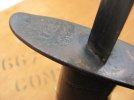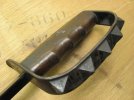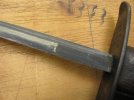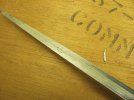- Joined
- Sep 24, 2002
- Messages
- 252
This is a first Model LF&C commando fighting knuckle knife WITH scabbard and hanger.
Has a triangular spike 8-3/4 inch blade. The hollow pyramid dragon's teeth are pointed. It measures 14 inches long overall.
It is U.S. L.F.& C. maker marked and 1917 dated on the knuckle bow. The wood is dark brown.
The knife is in very good condition. There is some areas of light surface rust on knuckle guard. Blade edges have a few very fine dings from sliding in & out of sheath. Point is undamaged. Most of bluing on blade is worn off. Wooden handle has a few dents but no cracks. Leather on sheath has no cracks , most of green paint is gone. You can still make out the "JEWEL 1918" stamped on leather, but it is faint. Metal parts on scabbard and hanger have some light surface rust.
These are quite scarce especially with scabbard.
Price is $400 shipped CONUS only (Paypal + 3% or MO) EMAIL FOR MORE PICTURES
Some History:
Early in WWI, the military realized they would need a fighting knife for use in trench warfare, so the hardware firm of Henry Disston & Sons was given the job of developing a suitable weapon.
The Disston designed knife is more of an "ice pick" bladed stabbing implement.
The triangular blade was 8 3/4" long, with a black finish.
The handle was walnut with shallow finger grooves.
The knuckle guard was formed of stamped steel with pressed out pyramid shaped points.
There was a conical staked nut holding the blade in the handle, and this could be used as a "skull cracker".
The scabbard was made of green tubular leather with a blackened steel tip and throat, with a standard wire pistol belt hook.
The scabbards were made by the Jewel Belt Co.
There was a second type, or version, often known as the 1918 model.
The only difference was, instead of having a row of pyramid shaped points running down the middle of the knuckle bow, the outer edges of the knuckle bow were formed into a double row of triangular, flange-like "teeth" which were folded down to form a double row of striking teeth.
The Model 1917/18 was made by the following companies:
Henry Diston & Sons-- HD&S
Onida Community Limited-- O.C.L.
Landers, Frary, & Clark-- L.F. & C.
American Cutlery Co.-- A.C. Co.





Has a triangular spike 8-3/4 inch blade. The hollow pyramid dragon's teeth are pointed. It measures 14 inches long overall.
It is U.S. L.F.& C. maker marked and 1917 dated on the knuckle bow. The wood is dark brown.
The knife is in very good condition. There is some areas of light surface rust on knuckle guard. Blade edges have a few very fine dings from sliding in & out of sheath. Point is undamaged. Most of bluing on blade is worn off. Wooden handle has a few dents but no cracks. Leather on sheath has no cracks , most of green paint is gone. You can still make out the "JEWEL 1918" stamped on leather, but it is faint. Metal parts on scabbard and hanger have some light surface rust.
These are quite scarce especially with scabbard.
Price is $400 shipped CONUS only (Paypal + 3% or MO) EMAIL FOR MORE PICTURES
Some History:
Early in WWI, the military realized they would need a fighting knife for use in trench warfare, so the hardware firm of Henry Disston & Sons was given the job of developing a suitable weapon.
The Disston designed knife is more of an "ice pick" bladed stabbing implement.
The triangular blade was 8 3/4" long, with a black finish.
The handle was walnut with shallow finger grooves.
The knuckle guard was formed of stamped steel with pressed out pyramid shaped points.
There was a conical staked nut holding the blade in the handle, and this could be used as a "skull cracker".
The scabbard was made of green tubular leather with a blackened steel tip and throat, with a standard wire pistol belt hook.
The scabbards were made by the Jewel Belt Co.
There was a second type, or version, often known as the 1918 model.
The only difference was, instead of having a row of pyramid shaped points running down the middle of the knuckle bow, the outer edges of the knuckle bow were formed into a double row of triangular, flange-like "teeth" which were folded down to form a double row of striking teeth.
The Model 1917/18 was made by the following companies:
Henry Diston & Sons-- HD&S
Onida Community Limited-- O.C.L.
Landers, Frary, & Clark-- L.F. & C.
American Cutlery Co.-- A.C. Co.





